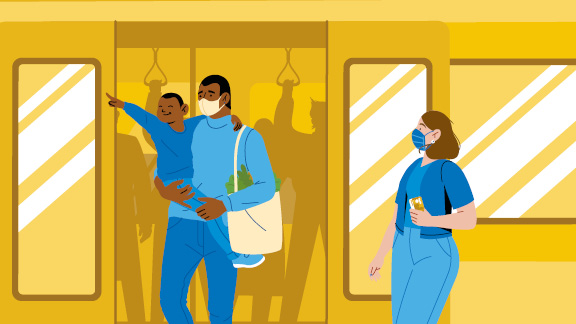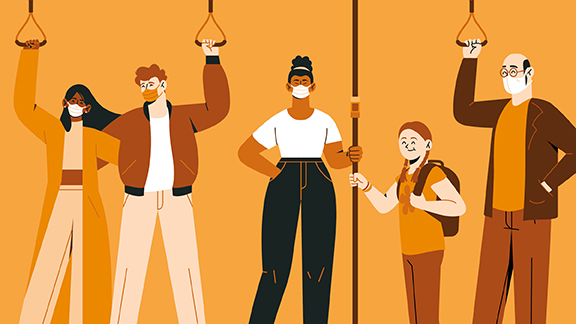Your safety is our top priority
In our buses, trams, and metros, on platforms, on public roads, … all these places entail safety rules. Please don’t take any shortcuts with your own safety. It is, after all, better to be safe than sorry.
Each year, millions of people use public transport in Brussels or come across STIB-MIVB vehicles.
Therefore, safety is a matter which concerns us all, anywhere, anytime. Learn all about our safety rules to travel safely and comfortably.
Our safety rules apply:
- When you’re waiting on a platform
- When you’re travelling on board our vehicles
- When you’re using public roads
List of links
Safety rules on public roads
Always give way to the tram
Whether you travel on foot, by bike or scooter or by car, always give way to the tram. Why?
- A tram is a heavy vehicle: its braking distance is longer than that of vehicles on tires
- A tram runs on rails: it cannot deviate from its course to steer round an obstruction
- A tram is moving fast: it needs tens of meter to come to a complete halt
Please be extra careful when crossing tram tracks. Take your time to look in both directions, as you do at a pedestrian crossing. You need to change lines? Please do not rush: staying safe is more important than going fast!

Do not drive on the bus lanes
Do not use bus lanes when driving your car. This is why:
- You are disrupting the bus transit
- You risk a collision with our vehicles
- You could obstruct the passage of emergency vehicles such as police cars, ambulances or fire engines who use bus lanes when responding to emergency situations
Driving a car in a bus lane is a first-degree traffic offence. You’re liable to a fine of minimum € 55.
Brussels is no filming location for an action movie nor a F1 circuit like Spa-Francorchamps! Please respect traffic regulations and speed limits and never drive in the bus lanes!
Wait until the bus has left its stop
In urban areas, a bus leaving its stop has priority. If it has turned its indicator lights on, overtaking is forbidden. Always wait for the bus to leave.
Are you using a bicycle, scooter or personal transporter? Be extra vigilant before overtaking a bus and seek visual contact in the rear-view mirror. A bus has 4 blind spots:
- The entire rear of the vehicle
- Just in front of the windscreen
- Part of the right side of the vehicle
- Part of the left side of the vehicle
A bus is quite long. If the driver hasn't seen you, he may put on his indicator light and pull out before you have finished overtaking.
Our safety rules clearly show that your safety is at the heart of our business, which is why we are striving to make our transport services as safe, accessible, and inclusive as possible. Do you want to know more about it? Discover the service we offer on our accessibility web page.
Safety rules on platforms
Stay behind the yellow line
When you are waiting for a metro or tram in a station, always stay behind the yellow line. This line marks a safe distance from the platform edge. Please only cross this line when the metro or tram has come to a complete halt and before the sound signal announces the closing of the vehicle doors.
This safety rule is even more important when you are travelling with a young child or with a pet. Moreover, please make sure you put your suitcase or your bag down at a safe distance from the platform edge.
What are the risks if you cross the line?
- You could fall on the tracks
- You could be blown off your feet by the air displaced when a vehicle is entering a station
- You could cause a service disruption and get fined
Never go on the tracks
You have dropped an item on the tracks? Please don’t put your life at risk by attempting to get down onto the tracks to retrieve your precious possession. Instead, speak to a STIB-MIVB agent in the station or use our call terminals to get in touch with a member of our staff.
Underground stations are environments where noises and sounds are coming from all directions. You really cannot trust your perceptions: it’s impossible to tell from which direction the tram or metro will be arriving, you’ll only know for sure when you see the vehicle entering the station.
Why is it dangerous to step onto the tracks?
- You could be electrocuted: the electrical power to operate our metro’s is supplied via the tracks, more precisely via a third track carrying 900 volts, which is as dangerous as a lightning strike
- You could have a fatal accident: our vehicles are long and heavy. Their braking distance is 40 meters. Even if the train driver has spotted you, it’s, unfortunately, already too late
- You might not get back onto the platform: given its height, it is not easy to climb right back onto the platform
We did the math: even the greatest sprinter, Usain Bolt, is not fast enough to outrun a metro!
This safety rule also applies to underground trams.
Put your foot down
Riding a bike or scooter is time saving. It can therefore be tempting to ride in stations... But not only is it forbidden, it is also very dangerous:
- Because you risk a deadly fall on a 900 volt track
- Because you could bump into people or fall over obstacles
- Because there are stairs, and that can hurt you
So don’ play with your life: park shared vehicles in the designated areas before entering the station or carry your personal vehicle by hand.

Reminder: bicycles are allowed on the metro and low-floor trams, except from 7am to 9am and from 4pm to 6.30pm. For more details, please check the Bicycle guide for passengers
Mind the gap between the vehicle and the platform
There is always a horizontal as well as a vertical gap between the vehicle and the platform. Please mind your step and make sure you don’t trip or fall when getting on or off:
- Hold on to handrails: take extra care in old trams, as steps in these vehicles are higher
- Be attentive: mind the gap and look where you are placing your feet
Rain can make platforms and vehicle entrances slippery. So please walk carefully on wet surfaces. You’ll avoid slips, falls and a wet bottom!
Give way to travellers who are exiting
Please stand back and allow travellers to get off before you boarding. Here are 3 reasons why:
- Common sense: why try to enter a vehicle when there’s no room since nobody can get off? Allow passengers to get off first and you’ll get on much more easily
- Swifter service: if getting on and off are logically organised, the dwell time of our vehicles at the stops will be reduced
- Safety: in addition to the unpleasant remarks you’re bound to get from fellow travellers, you could also injure yourself or others by squeezing yourself into the vehicle

Safety rules on board
Respect the beep
The sound signal, a long « BEEP », announces the imminent closing of the vehicle doors. Do not get on or off once you hear this warning beep. Here are 2 reasons why not:
- You could get injured by the closing doors
- An item could get trapped between the doors and cause damage when the vehicles drives off
- You can cause delay for your metro and all the following ones
The “BEEP” is no invitation to take your mark, get set and go! Even the Borlée brothers, very talented athletes, wouldn’t dare to sprint past the closing doors!
Do not block the doors
You’re late but determined to catch your bus? You’re distracted and forgot to get off the metro? The sound signal has just announced the closing of the tram doors? Please do not stop the doors from closing: it’s dangerous. Do not take the risk to get seriously injured just to gain a few seconds.
Why blocking the doors is dangerous?
- You could get hurt: vehicle doors close with considerable force and might cause injuries if you get caught
- You could get trapped and dragged along: the doors are equipped with an automatic detection system. But some very small items, like fingers or the straps of your handbag, may occasionally escape detection. As there is no alarm to alert the driver, the vehicle drives off and might drag you along the platform!
You’ve just missed your metro or tram? No worries: you’ll only need to wait a couple of minutes since our metro and tram services are operated with high frequency. It’s safe to say that your transport will arrive sooner than the fries you’ve ordered!
Hold on when standing during your journey
You could fall if you don’t hold on when the vehicle is in motion. Please be aware that a driver may be required to brake hard or make other manoeuvres to avoid a collision.
What are the risks if you don’t hold on?
- You could fall and get hurt
- You could bump into fellow travellers and injure them

The poles and handrails have not been installed for a fitness training or pole dancing class. They are there to ensure your safety. So, dear artists and acrobats, please hold on tight!
 Twitter
Twitter